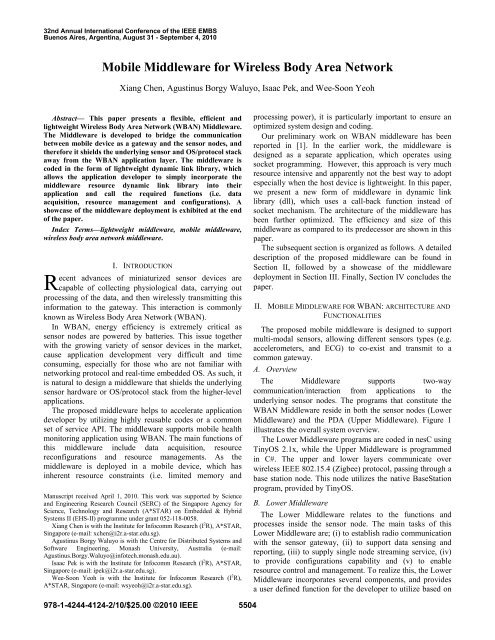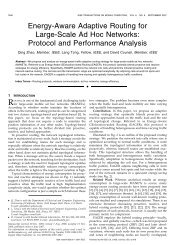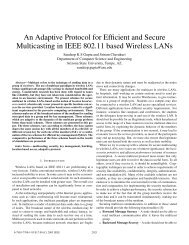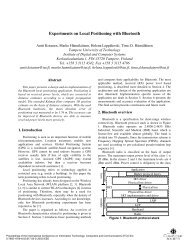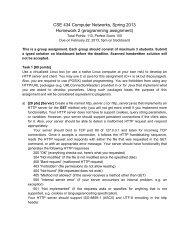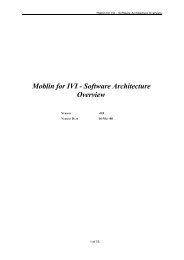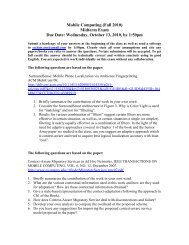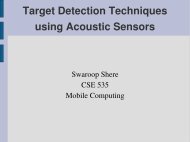Mobile Middleware for Wireless Body Area Network - IEEE Xplore
Mobile Middleware for Wireless Body Area Network - IEEE Xplore
Mobile Middleware for Wireless Body Area Network - IEEE Xplore
Create successful ePaper yourself
Turn your PDF publications into a flip-book with our unique Google optimized e-Paper software.
32nd Annual International Conference of the <strong>IEEE</strong> EMBS<br />
Buenos Aires, Argentina, August 31 - September 4, 2010<br />
<strong>Mobile</strong> <strong>Middleware</strong> <strong>for</strong> <strong>Wireless</strong> <strong>Body</strong> <strong>Area</strong> <strong>Network</strong><br />
Xiang Chen, Agustinus Borgy Waluyo, Isaac Pek, and Wee-Soon Yeoh<br />
Abstract— This paper presents a flexible, efficient and<br />
lightweight <strong>Wireless</strong> <strong>Body</strong> <strong>Area</strong> <strong>Network</strong> (WBAN) <strong>Middleware</strong>.<br />
The <strong>Middleware</strong> is developed to bridge the communication<br />
between mobile device as a gateway and the sensor nodes, and<br />
there<strong>for</strong>e it shields the underlying sensor and OS/protocol stack<br />
away from the WBAN application layer. The middleware is<br />
coded in the <strong>for</strong>m of lightweight dynamic link library, which<br />
allows the application developer to simply incorporate the<br />
middleware resource dynamic link library into their<br />
application and call the required functions (i.e. data<br />
acquisition, resource management and configurations). A<br />
showcase of the middleware deployment is exhibited at the end<br />
of the paper.<br />
Index Terms—lightweight middleware, mobile middleware,<br />
wireless body area network middleware.<br />
I. INTRODUCTION<br />
ecent advances of miniaturized sensor devices are<br />
Rcapable of collecting physiological data, carrying out<br />
processing of the data, and then wirelessly transmitting this<br />
in<strong>for</strong>mation to the gateway. This interaction is commonly<br />
known as <strong>Wireless</strong> <strong>Body</strong> <strong>Area</strong> <strong>Network</strong> (WBAN).<br />
In WBAN, energy efficiency is extremely critical as<br />
sensor nodes are powered by batteries. This issue together<br />
with the growing variety of sensor devices in the market,<br />
cause application development very difficult and time<br />
consuming, especially <strong>for</strong> those who are not familiar with<br />
networking protocol and real-time embedded OS. As such, it<br />
is natural to design a middleware that shields the underlying<br />
sensor hardware or OS/protocol stack from the higher-level<br />
applications.<br />
The proposed middleware helps to accelerate application<br />
developer by utilizing highly reusable codes or a common<br />
set of service API. The middleware supports mobile health<br />
monitoring application using WBAN. The main functions of<br />
this middleware include data acquisition, resource<br />
reconfigurations and resource managements. As the<br />
middleware is deployed in a mobile device, which has<br />
inherent resource constraints (i.e. limited memory and<br />
Manuscript received April 1, 2010. This work was supported by Science<br />
and Engineering Research Council (SERC) of the Singapore Agency <strong>for</strong><br />
Science, Technology and Research (A*STAR) on Embedded & Hybrid<br />
Systems II (EHS-II) programme under grant 052-118-0058.<br />
Xiang Chen is with the Institute <strong>for</strong> Infocomm Research (I 2 R), A*STAR,<br />
Singapore (e-mail: xchen@i2r.a-star.edu.sg).<br />
Agustinus Borgy Waluyo is with the Centre <strong>for</strong> Distributed Systems and<br />
Software Engineering, Monash University, Australia (e-mail:<br />
Agustinus.Borgy.Waluyo@infotech.monash.edu.au).<br />
Isaac Pek is with the Institute <strong>for</strong> Infocomm Research (I 2 R), A*STAR,<br />
Singapore (e-mail: ipek@i2r.a-star.edu.sg).<br />
Wee-Soon Yeoh is with the Institute <strong>for</strong> Infocomm Research (I 2 R),<br />
A*STAR, Singapore (e-mail: wsyeoh@i2r.a-star.edu.sg).<br />
processing power), it is particularly important to ensure an<br />
optimized system design and coding.<br />
Our preliminary work on WBAN middleware has been<br />
reported in [1]. In the earlier work, the middleware is<br />
designed as a separate application, which operates using<br />
socket programming. However, this approach is very much<br />
resource intensive and apparently not the best way to adopt<br />
especially when the host device is lightweight. In this paper,<br />
we present a new <strong>for</strong>m of middleware in dynamic link<br />
library (dll), which uses a call-back function instead of<br />
socket mechanism. The architecture of the middleware has<br />
been further optimized. The efficiency and size of this<br />
middleware as compared to its predecessor are shown in this<br />
paper.<br />
The subsequent section is organized as follows. A detailed<br />
description of the proposed middleware can be found in<br />
Section II, followed by a showcase of the middleware<br />
deployment in Section III. Finally, Section IV concludes the<br />
paper.<br />
II. MOBILE MIDDLEWARE FOR WBAN: ARCHITECTURE AND<br />
FUNCTIONALITIES<br />
The proposed mobile middleware is designed to support<br />
multi-modal sensors, allowing different sensors types (e.g.<br />
accelerometers, and ECG) to co-exist and transmit to a<br />
common gateway.<br />
A. Overview<br />
The <strong>Middleware</strong> supports two-way<br />
communication/interaction from applications to the<br />
underlying sensor nodes. The programs that constitute the<br />
WBAN <strong>Middleware</strong> reside in both the sensor nodes (Lower<br />
<strong>Middleware</strong>) and the PDA (Upper <strong>Middleware</strong>). Figure 1<br />
illustrates the overall system overview.<br />
The Lower <strong>Middleware</strong> programs are coded in nesC using<br />
TinyOS 2.1x, while the Upper <strong>Middleware</strong> is programmed<br />
in C#. The upper and lower layers communicate over<br />
wireless <strong>IEEE</strong> 802.15.4 (Zigbee) protocol, passing through a<br />
base station node. This node utilizes the native BaseStation<br />
program, provided by TinyOS.<br />
B. Lower <strong>Middleware</strong><br />
The Lower <strong>Middleware</strong> relates to the functions and<br />
processes inside the sensor node. The main tasks of this<br />
Lower <strong>Middleware</strong> are; (i) to establish radio communication<br />
with the sensor gateway, (ii) to support data sensing and<br />
reporting, (iii) to supply single node streaming service, (iv)<br />
to provide configurations capability and (v) to enable<br />
resource control and management. To realize this, the Lower<br />
<strong>Middleware</strong> incorporates several components, and provides<br />
a user defined function <strong>for</strong> the developer to utilize based on<br />
978-1-4244-4124-2/10/$25.00 ©2010 <strong>IEEE</strong> 5504
the nature of their application. The components and the<br />
functions are further described below.<br />
Sensor<br />
Gateway<br />
PDA(C#)<br />
<strong>Mobile</strong> Health Application<br />
<strong>Mobile</strong> <strong>Middleware</strong><br />
(Upper <strong>Middleware</strong>)<br />
<strong>Wireless</strong> Communication<br />
The ADC Channel should correspond to the physical<br />
hardware (i.e. the sensor should be physically connected to<br />
ADC Channel 1 - if “ADC_CHANNEL = 1” is specified).<br />
The Channel Number allows applications to determine the<br />
origin of the data in a radio packet. The channel number<br />
uniquely identifies each data stream originating from the<br />
sensor node (SingleChannelSensor only has one<br />
channel). The sampling rate parameter lets the developer to<br />
modify the sampling frequency of the sensor. To distinguish<br />
between different sensors, we provide sensor type parameter.<br />
Sensor Nodes<br />
(Lower <strong>Middleware</strong>)<br />
Figure 1. System overview<br />
• Components<br />
We have designed two Lower <strong>Middleware</strong> programs, one<br />
<strong>for</strong> a single stream of data coming out from the ADC (i.e.<br />
ECG) and another is <strong>for</strong> multiple data streams (i.e three-axis<br />
accelerometers), which is called SingleChannelSensor<br />
and MultipleChannelSensor, respectively. The<br />
graph component of the single stream of data is depicted in<br />
Figure 2. As can be seen from Figure 2, we employ<br />
BANMAC component as part of the program. This<br />
component is particularly responsible <strong>for</strong> the communication<br />
protocol between sensor nodes and sensor gateway. The<br />
protocol adopts a polling scheme, which follows a star<br />
topology and a master-slave model. This ensures that each<br />
sensor transmits the data reading at different times, and<br />
hence avoids collision. The BANMAC differs from standard<br />
polling in the sense that each transmission is preceded by a<br />
very short carrier sense period. A routine check to the<br />
channel in order to ensure it is free <strong>for</strong> transmission is<br />
carried out each time a packet is to be sent out. Further<br />
details of this BANMAC component can be found in [2].<br />
Other components include LedsC to control the light on the<br />
sensor, and a few Timers <strong>for</strong> data collection, sensor radio<br />
on/off, and battery reading.<br />
• User-defined Function and Parameter Setting<br />
The user-defined function and parameter setting are<br />
available to allow the application developer adjust the<br />
attributes of the parameters and process the data according to<br />
their requirements. Figure 3(a) indicates the parameter<br />
configurations in the header file. As shown in Figure 3(a),<br />
the appropriate ADC Channel (which the sensor is connected<br />
to) has to be specified.<br />
(a) Parameter configurations<br />
(b) User defined function<br />
Figure 3. Parameter configurations and User-defined function<br />
As an example, <strong>for</strong> accelerometer, the type is set to ‘1’,<br />
while ECG is ‘2’. The user-defined function as displayed in<br />
Figure 3(b), is called onBoardProcessing and supposed<br />
to be left empty by default. Developers can add in additional<br />
code which will be executed each time new data is<br />
successfully sampled. The Lower <strong>Middleware</strong> allows<br />
developers to per<strong>for</strong>m this function prior to data<br />
transmission. The example shown in Figure 3(b) divides the<br />
incoming data by 5 be<strong>for</strong>e they are transmitted out.<br />
C. Upper <strong>Middleware</strong><br />
The Upper <strong>Middleware</strong>’s role is to communicate with the<br />
Lower <strong>Middleware</strong> based on the given set of APIs. The<br />
architecture of the Upper <strong>Middleware</strong> can be seen in Figure<br />
4. We describe the call back function, reconfiguration and<br />
resource management features in the following.<br />
• Call back Function<br />
This call back function is implemented in the Upper<br />
<strong>Middleware</strong>, and is defined to serve the communication<br />
aspect between Upper <strong>Middleware</strong> and higher-level<br />
application.<br />
Msp430<br />
ADCxC<br />
(Sensorx)<br />
BANMessengerR<br />
(receiver)<br />
BANMessengerS<br />
(messenger2)<br />
Msp430<br />
ADCvC<br />
(Battery)<br />
Read<br />
<br />
BANReceive<br />
SingleChannelSensorC<br />
BANSend<br />
Read<br />
<br />
Boot<br />
Split<br />
Control Packet BANSend BANCtrl BANRadio<br />
Leds<br />
Ctrl<br />
Timer<br />
<br />
Timer<br />
<br />
Timer<br />
<br />
Timer<br />
<br />
MainC BANMessengerS BANMAC BAN<br />
(messenger1)<br />
Radio<br />
LedsC<br />
TimerMilliC<br />
DataCollection<br />
Timer<br />
TimerMilliC<br />
OneShot<br />
Timer<br />
TimerMilliC<br />
Toggle<br />
Timer<br />
TimerMilliC<br />
Battery<br />
Timer<br />
Figure 2. Lower <strong>Middleware</strong> components<br />
5505
Resource<br />
Control<br />
Command<br />
Application Layer ( <strong>Mobile</strong> Health Application)<br />
Notification<br />
and<br />
r esource<br />
in<strong>for</strong>mation<br />
Mote properties<br />
request and<br />
in<strong>for</strong>mation<br />
Incoming data streams<br />
with relevant mote ID and<br />
sensor type<br />
ResourceManager<br />
SensorHub MoteProperties<br />
Sensor Command<br />
Check Sensor<br />
Mote properties<br />
Request<br />
Response Interface<br />
update and<br />
in<strong>for</strong>mation<br />
Commands<br />
Sensor_RespMsg<br />
Incoming Data<br />
Resource<br />
Resource<br />
Streams and<br />
C heck Sensor Control<br />
In<strong>for</strong>mation<br />
set/update mote<br />
Command Interface Command<br />
Incoming Data<br />
properties<br />
Streams<br />
Sensor_CmdMsg SensorGateway<br />
DataManager MoteManager<br />
Mote<br />
updates<br />
Decrypts the<br />
Incoming Data<br />
Message<br />
Incoming and<br />
Outgoing Data<br />
Streams<br />
Check Sensor Data<br />
Interface<br />
Sensor_DataMsg<br />
COM port number of the attached base station node (see<br />
Figure 7). The SensorHub object is the main link between<br />
the application and the Upper <strong>Middleware</strong>. Each application<br />
should only create a single instance of SensorHub. A call<br />
to this function is necessary to begin receiving data from the<br />
sensor nodes. Without a call to this function, no<br />
data/responses from the sensor node network will be<br />
received by the application.<br />
SensorDecoder<br />
Sensor<br />
Nodes<br />
Gateway Node<br />
Encrypted <strong>Wireless</strong> Data Transmission<br />
SingleChannelSensor<br />
Multiple ChannelSensor<br />
Figure 4. Upper <strong>Middleware</strong> architecture<br />
This function replaces the threads in the socket<br />
programming. In this case, the application developer needs<br />
to define function delegates in which the Upper <strong>Middleware</strong><br />
will use to callback whenever new data/response arrives<br />
from the sensor nodes. As such, it is not necessary to<br />
maintain constant connection <strong>for</strong> checking purposes.<br />
Figure 5. Defining function delegates<br />
Upon defining function delegates shown in Figure 5, the<br />
application developer subsequently is required to assign the<br />
function delegates to local functions. The local function that<br />
we use as an example is called<br />
middlewareDataFunction <strong>for</strong> processes data and<br />
middlewareResponseFunction <strong>for</strong> processes<br />
responses (see Figure 6).<br />
Figure 7. Initiate the Upper <strong>Middleware</strong><br />
• Reconfiguration<br />
Reconfiguration feature enables applications to change the<br />
property of the sensors on-the-fly, such as changing the<br />
sampling rate of the sensor through the Upper <strong>Middleware</strong>.<br />
Figure 8 shows the reconfiguration functions in the Upper<br />
<strong>Middleware</strong>.<br />
Figure 8. Sensor reconfiguration functions<br />
• Resource Management<br />
Resource management relates to the ability to control each<br />
of the sensor nodes in the network. A set of resource control<br />
APIs is provided by the Upper <strong>Middleware</strong>. Resource<br />
control messages include sensor once-off and periodic sleep,<br />
sensor’s battery level reading and notification as depicted in<br />
Figure 9.<br />
Figure 9. Sensor resource management functions<br />
Figure 6. Assigning function delegates to local function<br />
The Upper <strong>Middleware</strong> will ‘callback’ incoming<br />
data/response to the application through these functions.<br />
Input parameters must be adhered to <strong>for</strong> them to function<br />
correctly. Define local data and response callback functions<br />
with the input parameters.<br />
The application developer may add the desired<br />
implementation/processing code into the body of the<br />
middlewareDataFunction. To initiate the upper<br />
<strong>Middleware</strong>, the developer firstly needs to create a new<br />
instance of SensorHub, passing as its input parameter the<br />
III. MIDDLEWARE DEPLOYMENT<br />
This section shows the deployment of the proposed<br />
middleware by an application. Our sensor hardware is a set<br />
of EHSII sensors, developed by the Embedded & Hybrid<br />
Systems II program in A*STAR [3] which have similar<br />
specifications as the Imperial College BSN motes [4].<br />
Figure 10. Sensor devices and a PDA<br />
5506
For this purpose, we utilize three accelerometers and one<br />
ECG, and the Upper <strong>Middleware</strong> resides in the PDA (HTC<br />
X7501 Advantage Ultra <strong>Mobile</strong>). Figure 10 shows the<br />
image of the associated sensor nodes and the mobile device.<br />
• Incorporating the <strong>Middleware</strong> into an Application<br />
As stated earlier, the proposed middleware is developed<br />
in C# in the <strong>for</strong>m of dll functions. In this showcase, we have<br />
developed a mobile health monitoring application that will<br />
deploy the middleware and interact with the sensor devices<br />
through the middleware. We are using Visual Studio 2008<br />
development suite. There are two simple steps to add the<br />
proposed middleware program into the application. The first<br />
step that application developer needs to do is to add a<br />
reference to the <strong>Middleware</strong>.dll in the project, by selecting<br />
‘Reference’ in the Solution Explorer as illustrated in Figure<br />
11(a). In this example, the <strong>Middleware</strong> dll is named<br />
<strong>Middleware</strong>.v3. Following this, in the second step, the<br />
developer will have to import the <strong>Middleware</strong>.v3 into<br />
the source code ‘using <strong>Middleware</strong>.v3’ statement at the<br />
header of the code (see Figure 11(b)). Subsequently, the<br />
application developer may commence deploying the<br />
middleware functions based on the procedures that have<br />
been described earlier in section IIC.<br />
• Parameter Setting Interface<br />
As part of the sensor reconfiguration and management<br />
features, the application should be built with an interface to<br />
utilize these features as what displayed in Figure 12(d). Each<br />
of these control command calls the relevant function given<br />
by the Upper <strong>Middleware</strong>. Figure 12(d) shows the radio<br />
toggle command has been triggered <strong>for</strong> sensor mote 4 and<br />
the sensor sends an acknowledgement back to the<br />
application.<br />
(a) Sensor indicators<br />
(b) Accelerometers wave<strong>for</strong>m<br />
(a) Reference the <strong>Middleware</strong><br />
(b) Import the <strong>Middleware</strong><br />
Figure 11. Incorporating <strong>Middleware</strong> dll<br />
• Data Acquisition<br />
After incorporating the middleware into the application<br />
and activating the data acquisition functions, the application<br />
should start receiving data streams from each of the sensor<br />
node. As shown in Figure 12(a), the light indicator in the<br />
application turns into green, which means that the<br />
application is receiving sensor data. The four lights indicates<br />
mote 1 to 4. Mote 1 to 3 corresponds to the three<br />
accelerometer sensors, while mote 4 relates to the ECG<br />
sensor. Figure 12(b) and (c) depicts the accelerometer and<br />
ECG wave<strong>for</strong>ms, respectively after receiving the data from<br />
the sensor nodes.<br />
(c) ECG wave<strong>for</strong>m (d) Sensor control interface<br />
Figure 12. Sensor data acquisition and presentation<br />
• Per<strong>for</strong>mance Comparison<br />
Compared to our previous WBAN middleware in [1], the<br />
<strong>Middleware</strong> reported in this paper offers much smaller size<br />
and better per<strong>for</strong>mance. The size of the previous Upper<br />
<strong>Middleware</strong> (106 bytes) is about two times larger than the<br />
current version (41 bytes) in this paper. In terms of the<br />
efficiency (loading time), the current middleware (~1.5 sec.)<br />
is about 5 to 6 times faster as compared to its predecessor<br />
(~10 sec.). These two are arguably the most significant<br />
elements when working in resource-constrained<br />
environments.<br />
IV. CONCLUSION<br />
We have presented an efficient, flexible and lightweight<br />
mobile middleware <strong>for</strong> wireless body area network. The<br />
middleware architecture, its functions/processes, and the<br />
deployment of the middleware including per<strong>for</strong>mance<br />
comparison of the middleware have been discussed.<br />
REFERENCES<br />
[1]. A.B.Waluyo, I. Pek, X. Chen and W-S. Yeoh, “SLIM: A Secured<br />
Lightweight Interactive <strong>Middleware</strong> <strong>for</strong> <strong>Wireless</strong> <strong>Body</strong> <strong>Area</strong><br />
<strong>Network</strong>” In Proc. of the 30th International Conference of the <strong>IEEE</strong><br />
Engineering in Medicine and Biology Society, pp. 1821–1824, 2008.<br />
[2]. Bd. Silva, A. Natarajan, M. Motani, and K-C. Chua, “Design<br />
Considerations of <strong>Body</strong> Sensor <strong>Network</strong>s”, In Proc. of the <strong>IEEE</strong><br />
Healthcom, pp.323-328, 2008.<br />
[3]. A*STAR,”EHSII: Embedded & Hybrid Systems II”, http://www.ehssg.org/.<br />
Referenced: April, 2009.<br />
[4]. B. Lo, S. Thiemjarus, R. King, and G-Z. Yang, “<strong>Body</strong> Sensor<br />
<strong>Network</strong> – A <strong>Wireless</strong> Sensor Plat<strong>for</strong>m <strong>for</strong> Pervasive Healthcare<br />
Monitoring”, In Proc. of the 3rd International Conference on<br />
Pervasive Computing, pp.77-80, 2005.<br />
5507


